The Role of Helminthophagous Fungi in the Biological Control of Human and Zoonotic Intestinal Helminths
IF 3.3
3区 医学
Q2 MICROBIOLOGY
引用次数: 0
Abstract
Nematophagous, or helminthophagous fungi of the genera Duddingtonia, Arthrobotrys, Monacrosporium, Pochonia, Paecilomyces, and Mucor, have been used over the years in in vitro and in vivo experiments to control helminth parasites that are potentially zoonotic. These fungi have shown efficacy against the following helminth genera: Ancylostoma, Toxocara, Enterobius, Strongyloides, Angiostrongylus, Taenia, Fasciola, and Schistosoma. The results obtained from these experiments, together with studies on soil contamination, suggest the viability of their use as a sustainable and effective strategy to reduce environmental contamination by these zoonotic parasites. Therefore, the aim of this review was to address the role of helminthophagous fungi in the biological control of potentially zoonotic helminths. To this end, we describe (1) a brief history of helminthophagous fungi; (2) a discussion of some potentially zoonotic intestinal parasites; (3) the importance of helminthophagous fungi in the control of nematodes, cestodes, and trematodes; and (4) the potential of helminthophagous fungi as a practical and sustainable strategy.嗜螺旋真菌在人类和人畜共患肠道蠕虫生物控制中的作用
多年来,Duddingtonia 属、Arthrobotrys 属、Monacrosporium 属、Pochonia 属、Paecilomyces 属和 Mucor 属的噬线虫真菌或噬蠕虫真菌已被用于体外和体内实验,以控制可能是人畜共患疾病的蠕虫寄生虫。这些真菌对以下蠕虫属具有疗效:Ancylostoma, Toxocara, Enterobius, Strongyloides, Angiostrongylus, Taenia, Fasciola, and Schistosoma。这些实验结果以及对土壤污染的研究表明,将其作为一种可持续的有效策略来减少这些人畜共患病寄生虫对环境的污染是可行的。因此,本综述旨在探讨嗜蠕虫真菌在潜在人畜共患病蠕虫的生物防治中的作用。为此,我们介绍了:(1)嗜蠕虫真菌的简史;(2)对一些潜在的人畜共患肠道寄生虫的讨论;(3)嗜蠕虫真菌在控制线虫、绦虫和颤虫方面的重要性;以及(4)嗜蠕虫真菌作为一种实用、可持续策略的潜力。
本文章由计算机程序翻译,如有差异,请以英文原文为准。
求助全文
约1分钟内获得全文
求助全文
来源期刊

Pathogens
Medicine-Immunology and Allergy
CiteScore
6.40
自引率
8.10%
发文量
1285
审稿时长
17.75 days
期刊介绍:
Pathogens (ISSN 2076-0817) publishes reviews, regular research papers and short notes on all aspects of pathogens and pathogen-host interactions. There is no restriction on the length of the papers. Our aim is to encourage scientists to publish their experimental and theoretical research in as much detail as possible. Full experimental and/or methodical details must be provided for research articles.
 求助内容:
求助内容: 应助结果提醒方式:
应助结果提醒方式:


